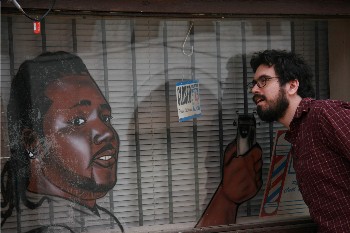Film Review: “Beeswax” — Hyper Realism Triumphant
by Justin Marble
Beeswax, directed by Andrew Bujalski, showing at Coolidge Corner Theatre.

Human to a Fault: Lauren (Maggie Hatcher) in Beeswax. Photo by Ethan Vogt.
Boston native Andrew Bujalski’s third feature film, “Beeswax,” does not reel off the trials and tribulations of superheroes, pirates, serial killers, or giant transforming robots. There’s no killer shark, no Godzilla, no guns, and no aliens. Brad Pitt and Julia Roberts do not star in this movie. Among its characters you’ll find nobody with a steely exterior concealing a heart of gold, a hit man searching for redemption, or an uptight workaholic learning to live in the moment. And that’s exactly what makes Bujalski’s effort so refreshing.
Instead, “Beeswax” focuses on a small clothing store owner named Jeannie (Tilly Hatcher), who faces a crisis when her friend and business partner Amanda (Anne Dodge), threatens to dissolve their partnership. She’s supported by her boyfriend Merrill (Alex Karpovsky), an aspiring law student, and her twin sister Lauren (Maggie Hatcher), who is at a bit of a crossroads in her own life. Midway through Jeannie’s dilemma, Lauren is offered a job halfway across the world in Kenya, and is forced to decide between her career and being there for her sister. What happens next? Well… they just… live.
A Hollywood executive, or a particularly jaded moviegoer, might read this synopsis and think “who cares?” Where’s the tension? Where’s the drama? And if one saw only the first half hour of “Beeswax,” they might feel the same way. Yet the power of this film lies in Bujalski’s ability to persuade the viewer to care about these extremely average, extremely human characters. He doesn’t use a big narrative twist or visual tricks to move the story along. These aren’t clichés, or archetypes, but real people, with all their dreams and flaws.
Like his previous films “Funny Ha Ha” and “Mutual Appreciation,” “Beeswax” self-consciously pits itself against standard Hollywood fare. It’s not escapism, but hyperrealism: the camera is treated as a window through which we view the lives of these characters.
Using nonprofessional actors, Bujalski’s tale of interpersonal conflict works because of his commitment to realism. Jeannie uses a wheelchair, not to make a grandiose statement about disability, but because actress Tilly Hatcher uses one in real life. She has a twin sister, because Maggie Hatcher is her twin in reality as well. Together these sisters serve as the emotional core of the film, and it is their journey that Bujalski is mainly concerned with. Rather than use professionals pretending to be sisters, he instead captures the empathy between two actual siblings, albeit in a fictionalized situation.

Beewax director Andrew Bujalski gets a trim. Photo by Cheree Franco.
Merrill provides a contrast to the sisters; at first he is witty, charming, and seemingly unflappable. But like his other characters, Bujalski also explores the moments where Merrill is not at his best, where he snaps at Jeannie, or where she takes him to task for being engaging when she is in trouble but distant when he doesn’t have a problem to solve. Jeannie similarly alternates between an endearing vulnerability and an obsession with control, possibly stemming from her disability. And Lauren may look as if she is an emotional constant, but she struggles with providing direction in her own life. It’s clear that Bujalski feels tenderness towards his characters, but that doesn’t stop him from admitting their faults, and displaying them onscreen.
Many critics have described “Beeswax,” like Bujalski’s other films, as being part of a movement known as “mumblecore,” (Bujalski himself does not like the term), because of the “ums,” “uhs,” “maybes,” and “I don’t knows” that are sprinkled heavily through the dialogue. The characters’ insecurity manifests itself in nearly every interaction in the film, making most exchanges painfully awkward and exacting. Whether someone identifies with “Beeswax” or not most likely lies in their personal ability to navigate social situations. Prom kings and homecoming queens may not get where Bujalski is coming from. Or perhaps they will.
If there’s a fault in “Beeswax,” it may lie in the fact that this quirkiness and timidity can dominate some scenes and prove tiresome at points. While all his films are interesting, there is a similarity in the way Bujalski’s characters interact, a sameness that he has yet to move beyond. It may just be his way of seeing the world, and to ignore that would be untruthful. And his films are in such stark contrast to most other recent Hollywood films, with the possible exception of an effort such as “Rachel Getting Married,” that it’s not a problem to spend an hour and a half in his unique vision.
“Beeswax” ultimately reminds us that not all of cinema must exist in fantasyland. Bujalski calls our attention to the stories, the drama, the connections right underneath our noses. “Beeswax” captures a moment in time and makes you care about the people involved- not because they are sexy, or because they have superpowers, but because they are like us. There’s still value in close observation of the everyday, and it would be a shame to overlook it.
Tagged: Andrew Bujalski, Beeswax, Boston native, Film, Funny Ha Ha, Justin Marble
